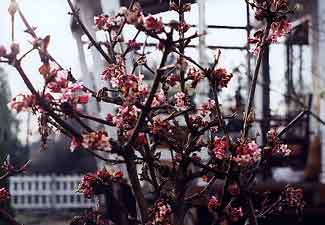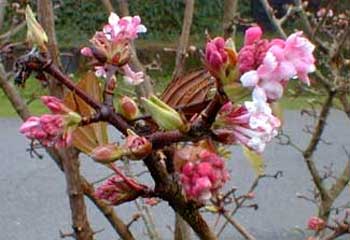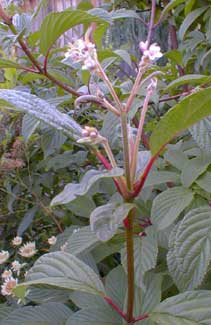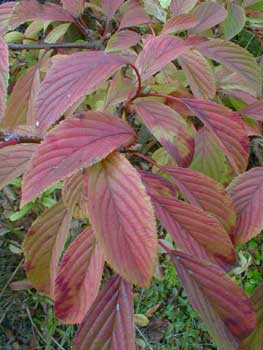 Winter Blooms of
Winter Blooms of
Pink Dawn Viburnum
"The ivy, hop, viburnum, which around
This ruin gather, all to them unknown
Whether 'twas Silvan, Pan, Hermes or Faun,
Its maimed front their twining horns have found."
-Jose Maria de Heredia the Younger
(1842-1905)
(1842-1905)
We have two Dawn Viburnums (Viburnum bodnantense 'Dawn'), which was still called "Pink Dawn" when we obtained our first one, but the "Pink" part of the name has for reasons unknown to me been dropped in nearly all current listings. It is a hybrid developed in Germany by crossing the Chinese V. farreri with the Himalayan V. grandiflorum.
 The first one we obtained is in the back yard, shown at top left in winter bloom. It was trained as a single-trunked little tree about six feet tall when we planted it, & a solid eight feet or so as of 2003, with random branches shooting upward much taller.
The first one we obtained is in the back yard, shown at top left in winter bloom. It was trained as a single-trunked little tree about six feet tall when we planted it, & a solid eight feet or so as of 2003, with random branches shooting upward much taller.When it sends a random branch upward, extraoardinarily swift in its growth, the highest point of the mini-tree is thirteen feet or higher. Although we want to encourage it to put on as much height as it wishes, we want it to be branching, & one or two rigidly upright branches look wrong poking out of the main body of the little tree. So we do prune its upward branches at points of buds to encourage forking. To keep the tree-form intact it is also necessary to remove suckers from time to time. Apart from practical considerations of form, it does not require pruning to grow & bloom well.
Our other Dawn Viburnum is by the road, with December blooms shown here at the right. It's quite different because it is growing in the wild manner as a multiply trunked shrub. It was previously taller than the one in the back yard, but is growing more slowly while the back yard specimen has outgrown the roadside specimen in terms of height. We permit this one to grow as it pleases, so it is a big multi-branching shrub. It doesn't demand to be pruned, though if it is done, just before its spring burst of leaf growth is the time.
 The back yard specimen gets only morning sun & plenty of water. The roadside specimen gets harsh sun exposure all afternoon in a sometimes droughty sun-garden, & it is doing spectacularly well also.
The back yard specimen gets only morning sun & plenty of water. The roadside specimen gets harsh sun exposure all afternoon in a sometimes droughty sun-garden, & it is doing spectacularly well also.Its interesting crusty bark lends it a winter interest (see the Dawn Viburnum Page along the Winter Bark Garden Walk). But it is most famed as a winter bloomer. If you want one of these excellent plants for maximum winter effect, get the most mature specimen you can afford, or you may have to wait a couple years to see the blooms. The flowers have a pleasing perfume, sweeter than the smell of the leaves of spring through autumn, the leaves smelling citrusy if bruised.
 The flowers are pinkest & most dramatic in winter when deciduous leaves have fallen & the zizzag of branches shows only bright pink buds & light pink blossoms. In other seasons the flowers are pinkish white; they tend to become hidden flowers once the spring leaves are well along, enveloping the blooms, but it doesn't necessarily stop blooming. Ours blooms most appealingly in winter as it's supposed to, but it produces a few paler flowers unpredictably in other seasons, easily missed in the dense foliage.
The flowers are pinkest & most dramatic in winter when deciduous leaves have fallen & the zizzag of branches shows only bright pink buds & light pink blossoms. In other seasons the flowers are pinkish white; they tend to become hidden flowers once the spring leaves are well along, enveloping the blooms, but it doesn't necessarily stop blooming. Ours blooms most appealingly in winter as it's supposed to, but it produces a few paler flowers unpredictably in other seasons, easily missed in the dense foliage.The roadside specimen has fewer flowers out of season, but the backyard specimen has a second full flower period in late July & early August. The third photo from late July also gives a good impression of the deeply creased citrusy leaves.
It starts to develop small berries off the winter blooms as early as May, which ripen to a rich blue by autumn, when leaves gain sheens of bronzy-red before falling. The photo from late October (2005) shows what is about the maximum reds these leaves acquire. For the full range of fall colors, see the Dawn Viburnum Page in the Autumn Leaves Gallery.
The roadside shrub with the most sun gets more berries & redder leaves than the much more protected back yard specimen. Neither has produced a lot of the berries, though enough to add one more interesting feature.
It is not picky as to location, liking sun but getting by with part shade; enjoying acid soil but doing well enough in other soils; & is fairly cold-hardy, though at temperatures below zero degrees F., it should have a protected placement where the chilliest winds won't hit it. So too it prefers coolness but won't do badly in heat. Overall, this hybrid is just wonderfully adaptable.
This shrub or small tree has become extremely popular all around Puget Sound, where conditions are perfect for it. It has come to rival the popularity of Witch Hazel, likewise prized for winter blossoms.